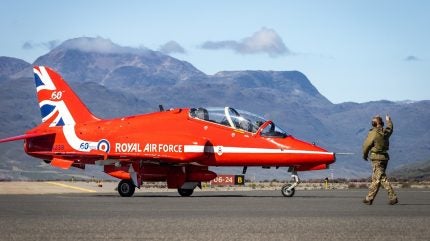
The UK Royal Air Force (RAF) has not exhausted its fleet of elderly Hawk T1 aircraft just yet.
Approaching 50 years of service, the aircraft still perform aerobatic displays as part of the Red Arrows team in an effort to exhibit the very best of British aeronautical prowess. However, as training jets, the units went out of service almost three years ago.
Since then, Maria Eagle, the Minister of Defence Procurement, cited steady figures from the fleet’s fatigue index value – which estimates the platform’s rate of decline – in a parliamentary written repsonse on 16 January 2025.
According to the government, the percentage of the fatigue index used ranges between 68.31% and 94.65%. This means that, on average, the RAF have used close to 79% of Hawk’s fatigue index and is now left with just over 20%.
These figures demonstrate that, across all 26 airframes, the service still retains “more than sufficient overall remaining available fatigue life.” The Minister assured a colleague that this will last until their retirement in 2030.
For the Ministry of Defence (MoD), these findings contrast with speculation of the potential early retirement of the Red Arrows due to exhaustion. However, as the retirement of Hawk T1 approaches the government still have not committed to a new contract to replace these ageing aircraft which serve diplomatic and presentational purposes.

US Tariffs are shifting - will you react or anticipate?
Don’t let policy changes catch you off guard. Stay proactive with real-time data and expert analysis.
By GlobalDataSimilarly, this corresponds with the MoD’s decision to hold back from ordering any new Eurofighter Typhoon jets. While all three partner nations have opted for more, the UK is alone in its apathy.
Replacing Hawk T1 and T2
Hawk T2, the successor platform to the T1 and T1A variants – and differentiated by improvements in avionics, engine, and cockpit – is beginning to face obselesence as a training aircraft.
As a trainer for pilots to go on to fly Typhoon and F-35, both fourth and fifth generation combat aircraft, the T2’s sunset years will overlap with the emergence of the UK’s sixth gen Future Combat Air System, or ‘Tempest’.
Sixth-generation brings with it an understanding that an advanced crewed fighter jet will operate with other autonomous air vehicles as part of a hybrid formation with attritable mass.
The complexity of crewed-uncrewed teaming will put more pressure on simulators and conventional training aircraft. The demand for replicating integrated combat with autonomous systems will require a lot innovation. And it is unlikely this will come before the T2 leaves service in 2040.
While the previous Conservative government had planned to investigate the T2 replacement, details of replacing Hawk T1 and T2 will come with the new Labour government’s completion of the Strategic Defence Review in the spring of this year.
There is still hope for the Hawk, however, as Eagle implied in another response on 16 December 2024 regarding closer collaboration between Qatar and the UK when it comes to their shared aerial capabilities.
“We have agreed to deepen cooperation,” Eagle stated, and “this includes undertaking opportunities to strengthen our respective defence capabilities through broadening our cooperation on the Typhoon and Hawk partnerships.”
This future collaboration – and it is not yet known what this will look like – will build on the Joint Hawk Training Squadron, situated at RAF Leeming in Yorkshire since its creation in 2021.



